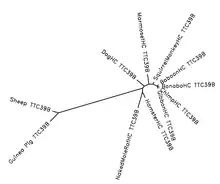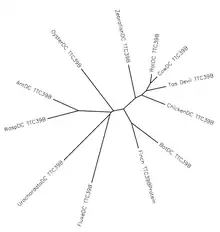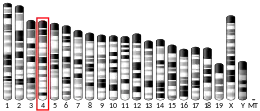| TTC39B | |||||||||||||||||||||||||||||||||||||||||||||||||||
|---|---|---|---|---|---|---|---|---|---|---|---|---|---|---|---|---|---|---|---|---|---|---|---|---|---|---|---|---|---|---|---|---|---|---|---|---|---|---|---|---|---|---|---|---|---|---|---|---|---|---|---|
| Identifiers | |||||||||||||||||||||||||||||||||||||||||||||||||||
| Aliases | TTC39B, C9orf52, tetratricopeptide repeat domain 39B | ||||||||||||||||||||||||||||||||||||||||||||||||||
| External IDs | OMIM: 613574 MGI: 1917113 HomoloGene: 25228 GeneCards: TTC39B | ||||||||||||||||||||||||||||||||||||||||||||||||||
| |||||||||||||||||||||||||||||||||||||||||||||||||||
| |||||||||||||||||||||||||||||||||||||||||||||||||||
| |||||||||||||||||||||||||||||||||||||||||||||||||||
| |||||||||||||||||||||||||||||||||||||||||||||||||||
| Wikidata | |||||||||||||||||||||||||||||||||||||||||||||||||||
| |||||||||||||||||||||||||||||||||||||||||||||||||||
Tetratricopeptide repeat protein 39B is a protein that in humans is encoded by the TTC39B gene. TTC39B is also known as C9orf52 or FLJ33868. The main feature within tetratricopeptide repeat 39B is the domain of unknown function 3808 (DUF3808), spanning the majority of the protein.
Gene
The gene for TTC39B is located on the short arm of the ninth chromosome at 9p22.3. The genomic DNA is 136,517 bases long, consists of 39 introns and 20 exons, and is on the minus strand. The mRNA has a length of 3,276 bases. TTC39B is surrounded by LOC100419056, a chloride channel, voltage-sensitive 3 pseudogene.[5]
Function
TTC39B is expected to have a molecular binding function as well as a role in lipid regulation; the phenotype as well as the function in vivo is unknown.[6]
Homology and evolution
Paralogs
There are two known paralogs for TTC39B: TTC39A and TTC39C. TTC39A has two splice isoforms and TTC39C has three splice isoforms.
TTC39A has been tested for association to diseases like breast neoplasms and is expected to have molecular binding function and localizes in various compartments (extracellular space, membrane, nucleus).[7]
TTC39C is expected to localize in cytoplasm. No phenotype has been discovered, and the gene's in vivo function is unknown.[8]
Orthologs
| Genus and Species | Common Name | RNA Percent Identity | Divergence |
|---|---|---|---|
| Pan paniscus | Bonobo | 99% | 6.3 MYA |
| Pan troglodytes | Chimpanzee | 99% | 6.3 MYA |
| Gorilla gorilla gorilla | Gorilla | 99% | 8.8 MYA |
| Nomascus leucogenys | Gibbon | 98% | 20.4 MYA |
| Papio anubis | Baboon | 97% | 29.0 MYA |
| Pongo pygmaeus | Orangutan | 97% | 15.7 MYA |
| Callithrix jacchus | Marmoset | 96% | 42.6 MYA |
| Saimiri boliviensis boliviensis | Squirrel monkey | 94% | 42.6 MYA |
| Canis lupus familiaris | Dog | 91% | 94.2 MYA |
| Otolemur garnettii | Bushbaby | 90% | 74.0 MYA |
| Felis catus | Cat | 89% | 94.2 MYA |
| Bos taurus | Cow | 88% | 94.2 MYA |
| Cricetulus griseus | Hamster | 87% | 92.3 MYA |
| Ovis aries | Sheep | 85% | 94.2 MYA |
| Rattus norvegicus | Rat | 85% | 92.3 MYA |
Distant homologs
| Genus and Species | Common Name | RNA Percent Identity | Divergence |
|---|---|---|---|
| Sarcophilus harrisii | Tasmanian devil | 78% | 162.6 MYA |
| Gallus gallus | Chicken | 75% | 296.0 MYA |
| Taeniopygia guttata | Zebra finch | 75% | 296.0 MYA |
| Anolis carolinensis | Lizard | 75% | 296.0 MYA |
| Xenopus laevis | Frog | 74% | 371.2 MYA |
Phylogeny
TTC39B is conserved in organisms from human to platyhelminthes and is not conserved in yeast and fungi.


Protein
The TTC39B gene has five different transcript variants, each coding for a different protein. This article focuses on tetratricopeptide repeat protein 39B isoform 1, the longest of all of the proteins. When translated, the TTC39B protein is composed of 682 amino acids and has a molecular weight of 76,955.64 kDa. The isoelectric point of the protein is 7.16 pH.[9]
Conservation
Close Orthologs:
| Genus and Species | Common Name | Protein Percent Identity | Divergence |
|---|---|---|---|
| Pan troglodytes | Chimpanzee | 99% | 6.3 MYA |
| Pan paniscus | Bonobo | 99% | 6.3 MYA |
| Nomascus leucogenys | Gibbon | 98% | 20.4 MYA |
| Papio anubis | Baboon | 98% | 29.0 MYA |
| Callithrix jacchus | Marmoset | 97% | 42.6 MYA |
| Saimiri boliviensis boliviensis | Squirrel monkey | 96% | 42.6 MYA |
| Heterocephalus glaber | Naked mole-rat | 92% | 92.3 MYA |
| Canis lupus familiaris | Dog | 91% | 94.2 MYA |
| Cricetulus griseus | Hamster | 90% | 92.3 MYA |
| Ovis aries | Sheep | 89% | 94.2 MYA |
| Cavia porcellus | Guinea pig | 86% | 92.3 MYA |
Distant Orthologs:
| Genus and Species | Common Name | Protein Percent Identity | Divergence |
|---|---|---|---|
| Sarcophilus harrisii | Tasmanian devil | 73% | 162.6 MYA |
| Taeniopygia guttata | Zebra finch | 72% | 296.0 MYA |
| Pteropus alecto | Bat | 55% | 94.2 MYA |
| Bos taurus | Cow | 54% | 94.2 MYA |
| Rattus norvegicus | Rat | 54% | 92.3 MYA |
| Gallus gallus | Chicken | 54% | 296.0 MYA |
| Danio rerio | Zebrafish | 54% | 400.1 MYA |
| Crassostrea gigas | Oyster | 50% | 782.7 MYA |
| Camponotus floridanus | Ant | 43% | 782.7 MYA |
| Nasonia vitripennis | Wasp | 42% | 782.7 MYA |
| Ciona intestinalis | Urochordata | 40% | 722.5 MYA |
| Clonorchis sinensis | Liver fluke | 35% | 792.4 MYA |
Domains and motifs
The Domain of Unknown Function 3808 (DUF3808) domain is conserved from fungi to humans and is currently has an unknown function. It is located from amino acid 142 until 568 (a length of 427 amino acids). Proteins of this family also contain a TPR_2 domain at their C-terminus, which also has an unknown function.[10]
Another conserved domain in the TTC39B protein is the TPR_12 tetratricopeptide repeat. It is located from amino acid 600 until 658 (a length of 59 amino acids).[11] The TPR domains are found in many proteins that facilitate specific interactions with a partner protein. Three-dimensional structural data have shown that a TPR region forms two antiparallel alpha-helices. TPR motifs that are arranged one in front of another create a right-handed helical structure with an amphipathic channel which could possibly accommodate the complementary region of a target protein. Most TPR-containing proteins are associated with multiprotein complexes, and there is extensive evidence indicating that TPR motifs are important to the functioning of chaperone, cell-cycle, transcription, and protein transport complexes.[12] Two more TPR domains are found in the TTC39B protein: TPR1 which spans from amino acids 393 to 426 (34 amino acids long) and TPR2 which spans from amino acids 626 to 659 (also 34 amino acids long).[13]
TTC39B contains three transmembrane regions, all located within the DUF3808 region.[14] Since there are three transmembrane regions, the N-terminus and C-terminus of the protein will be on opposite sides of the plasma membrane.
Post-translational modifications
Phosphorylation Sites:[15]
| Amino Acid | Position |
|---|---|
| Serine (S) | 28, 32, 42, 51, 61, 62, 72, 91, 93, 94, 96, 101, 102, 107, 120, 123, 124, 125, 126, 127, 134, 148, 165, 173, 194, 215, 217, 218, 221, 224, 229, 270, 279, 305, 313, 329, 344, 347, 350, 365, 393, 421, 454, 461, 464, 477, 500, 509, 524, 526, 548, 551, 557, 573, 578, 580, 614, 634, 638, 660, 663, 680, 681 |
| Threonine (T) | 89, 100, 110, 121, 128, 152, 174, 183, 202, 211, 250, 269, 356, 362, 370, 467, 487, 493, 512, 563, 628, 651 |
| Tyrosine (Y) | 167, 172, 206, 210, 239, 271, 274, 295, 363, 398, 434, 451, 452, 453, 468, 523, 542, 608, 620, 623, 636, 656, 659 |
Probability of Sumoylation Sites[16] (bolded):
| No. | Position | Group | Score |
|---|---|---|---|
| 1 | 619 | ESEKL LKYD HYLVP | 0.91 |
| 2 | 262 | NMINF IKGG LKIRT | 0.77 |
| 3 | 302 | EFEGG VKLG SGAFN | 0.76 |
| 4 | 133 | STKVD LKSG LEECA | 0.73 |
There is one possible N-glycosylation site at amino acid 391, however, since the TTC39B protein does not contain a signal peptide, it is unlikely that this glycosylation actually occurs.
Secondary structure
According to an analysis of the secondary protein structure, TTC39B is most likely to be expressed in the endoplasmic reticulum, mitochondria, and Golgi apparatus.[14]
Tertiary and quaternary structure
The TTC39B protein folds into an alpha-alpha super helix. 40% of its structure matches with d1w3ba, the superhelical domain of o-linked GlcNAc transferase. O-GlcNAc couples metabolic status to the regulation of a wide variety of cellular signaling pathways by acting as a nutrient sensor.[17]
Expression
Promoter and transcription start site
The promoter for TTC39B starts at base pair 15,307,109 and ends at base pair 15,307,858. It has a length of 750 base pairs. The transcription start site for TTC39B protein isoform 1 is located from base pairs 15,307,340 to 15,307,389 and has a length of 50 bp.
Expression profile
TTC39B is well expressed in muscles, internal organs, secretory organs, reproductive organs, the immune system, and the nervous system.[6] TTC39B is expressed in a multitude of tissues: testis, lung, islets of langerhans, pancreas, kidney, pooled germ cell tumors, breast carcinoma, etc.[6]
Transcript variants
There are five different transcript variants for the TTC39B gene. Isoform 1 is the longest transcript and encodes the longest isoform. Isoform 2 uses an alternate in-frame splice site in the central coding region, compared to variant 1, which results in a shorter protein. Isoform 3 and 4 have multiple differences in the central coding region but maintain the reading frame compared to isoform 1. Isoform 5 differs in the 5' UTR and has multiple coding region differences, compared to variant 1. These differences cause translation initiation at an in-frame downstream AUG and results in isoform 5 having a shorter N-terminus compared to isoform 1.[18]
Interacting proteins
Binding transcription factors
Transcription Factor Binding Sites:[19]
| Matrix Family | Detailed Family Information | From | To | Strand | Similarity | Sequence (CAPITALS: core sequence) |
|---|---|---|---|---|---|---|
| V$PLAG | Pleomorphic adenoma gene | 51 | 73 | (+) | 1.000 | taGGGGgaagtagaggagttcca |
| V$TALE | TALE homeodomain class recognizing TG motifs | 157 | 173 | (+) | 1.000 | ggtggtgtGTCAgaggc |
| V$ZF02 | C2H2 zinc finger transcription factors 2 | 294 | 316 | (-) | 1.000 | cagcgCCCCacctggggtccgtg |
| V$MIZ1 | Myc-interacting Zn finger protein 1 | 417 | 427 | (-) | 1.000 | cacgcCCTCtg |
| O$TF2B | RNA polymerase II transcription factor II B | 517 | 523 | (-) | 1.000 | ccgCGCC |
Cellular Proteins
TTC39B interacts with ubiquitin C (UBC), a polyubiquitin precursor. Conjugation of ubiquitin monomers or polymers leads to different effects within a cell. Ubiquitination has been associated with protein degradation, DNA repair, cell cycle regulation, kinase modification, endocytosis, and regulation of other cell signaling pathways.[20]
Clinical significance
Disease association
On a locus on chromosome 9p22 found to be associated with high-density lipoprotein (HDL-C), TTC39B was the only one of several genes in the locus to have an eQTL in liver, with the allele associated with decreased expression correlating with increased HDL-C. Knockdown of the mouse ortholog TTC39B via a viral vector (50% knockdown) resulted in significantly higher plasma HDL-C levels at 4 days and 7 days. The data indicates that TTC39B as causal genes for lipid regulation.[21]
References
- 1 2 3 GRCh38: Ensembl release 89: ENSG00000155158 - Ensembl, May 2017
- 1 2 3 GRCm38: Ensembl release 89: ENSMUSG00000038172 - Ensembl, May 2017
- ↑ "Human PubMed Reference:". National Center for Biotechnology Information, U.S. National Library of Medicine.
- ↑ "Mouse PubMed Reference:". National Center for Biotechnology Information, U.S. National Library of Medicine.
- ↑ "LOC100419056 chloride channel, voltage-sensitive 3 pseudogene". NCBI. Retrieved 13 May 2013.
- 1 2 3 "TTC39B, a comprehensive annotation of human, mouse, and worm genes with mRNAs or ESTsAceView". AceView. Retrieved 13 May 2013.
- ↑ "TTC39A, a comprehensive annotation of human, mouse, and worm genes with mRNAs or ESTsAceView". AceView. Retrieved 13 May 2013.
- ↑ "TTC39C, a comprehensive annotation of human, mouse, and worm genes with mRNAs or ESTsAceView". AceView. Retrieved 13 May 2013.
- ↑ "Tetratricopeptide repeat protein 39B isoform 1 [Homo sapiens] - Protein - NCBI".
- ↑ "NCBI". Retrieved 9 May 2013.
- ↑ "NCBI". Retrieved 9 May 2013.
- ↑ Blatch GL, Lässle M (November 1999). "The tetratricopeptide repeat: a structural motif mediating protein-protein interactions". BioEssays. 21 (11): 932–9. doi:10.1002/(SICI)1521-1878(199911)21:11<932::AID-BIES5>3.0.CO;2-N. PMID 10517866.
- ↑ "NP_689787.2: TTC39B gene product [Homo sapiens]". NCBI. Retrieved 13 May 2013.
- 1 2 "Biology Workbench". SDSC Biology Workbench. Retrieved 13 May 2013.
- ↑ "NetPhos 2.0 Server". Center for Biological Sequence Analysis. Retrieved 13 May 2013.
- ↑ "SUMOsp 2.0 - SUMOylation Site Prediction". The CUCKOO Workgroup. Retrieved 13 May 2013.
- ↑ Lazarus MB, Nam Y, Jiang J, Sliz P, Walker S (January 2011). "Structure of human O-GlcNAc transferase and its complex with a peptide substrate". Nature. 469 (7331): 564–7. Bibcode:2011Natur.469..564L. doi:10.1038/nature09638. PMC 3064491. PMID 21240259.
- ↑ "TTC39B tetratricopeptide repeat domain 39B [Homo sapiens (human)]". NCBI. Retrieved 13 May 2013.
- ↑ "GEMS Launcher: Matlnspector: Search for transcription factor binding sites". Genomatix Software Suite. Retrieved 13 May 2013.
- ↑ "UBC Gene - GeneCards". GeneCards. Retrieved 13 May 2013.
- ↑ Teslovich TM, Musunuru K, Smith AV, et al. (August 2010). "Biological, clinical and population relevance of 95 loci for blood lipids". Nature. 466 (7307): 707–13. Bibcode:2010Natur.466..707T. doi:10.1038/nature09270. PMC 3039276. PMID 20686565.



